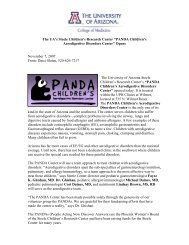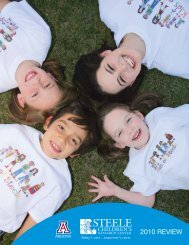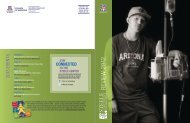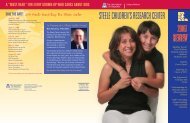2006 Annual Report - the Steele Children's Research Center ...
2006 Annual Report - the Steele Children's Research Center ...
2006 Annual Report - the Steele Children's Research Center ...
Create successful ePaper yourself
Turn your PDF publications into a flip-book with our unique Google optimized e-Paper software.
“Zoo Baby” on loan to <strong>the</strong><br />
<strong>Steele</strong> <strong>Center</strong> from <strong>the</strong> Morse<br />
family collection.<br />
In Memoriam<br />
Sidney Slim Morse<br />
October 27, 1934 – February 1, <strong>2006</strong><br />
The <strong>Steele</strong> Children’s <strong>Research</strong> <strong>Center</strong> lost a good friend on February 1,<br />
<strong>2006</strong> when Sidney Slim Morse passed away while undergoing treatment for<br />
leukemia at Johns Hopkins Hospital in Baltimore.<br />
Sid and Faye Morse moved to Tucson from Los Angeles in 1994. They<br />
embraced Tucson and quickly became well-known and well-loved members<br />
of our community.<br />
Sid was an advocate for children, healthcare and education. He was<br />
named a 1984 Fa<strong>the</strong>r of <strong>the</strong> Year in Los Angeles and was a founding<br />
member of <strong>the</strong> board of directors of Fa<strong>the</strong>r’s Day Council Tucson, where he<br />
served for 12 years until his death. Fa<strong>the</strong>r’s Day Council Tucson has raised<br />
more than $1 million to benefit research dedicated to finding a cure for<br />
type 1 diabetes (formerly known as juvenile diabetes). FDC Tucson pledges<br />
all proceeds from its fundraising efforts to support <strong>the</strong> type 1 diabetes<br />
program at <strong>the</strong> <strong>Steele</strong> Children’s <strong>Research</strong> <strong>Center</strong>.<br />
Sid also served on <strong>the</strong> board of directors of <strong>the</strong> Pima Community<br />
College Foundation, Outward Bound International, Rotary Club of<br />
Tucson and numerous o<strong>the</strong>r organizations. In 2001, he was named<br />
Tucson’s Philanthropist of <strong>the</strong> Year in recognition of his generosity and<br />
commitment to many charitable causes in our community.<br />
Sid’s generosity has left a lasting legacy at <strong>the</strong> <strong>Steele</strong> <strong>Center</strong>. As<br />
children and <strong>the</strong>ir families enter The Arizona Elks Clinic for Children and<br />
Young Adults, <strong>the</strong>y are greeted by Zoo Babies—beautiful photographs of<br />
baby animals from <strong>the</strong> Morse family collection—that never fail to bring<br />
enjoyment and a smile to <strong>the</strong> faces of children and adults alike.<br />
– Susan Mannion, Fa<strong>the</strong>rs Day Council, Tucson<br />
<strong>Steele</strong> <strong>Center</strong> <strong>Research</strong>ers Discover<br />
Protein Plays Role in Sickle Cell Anemia<br />
and O<strong>the</strong>r Blood Diseases<br />
<strong>Steele</strong> <strong>Center</strong> researchers Murray Brilliant, PhD, Lindholm Professor<br />
of Mammalian Genetics, and Orit Cohen-Barak, PhD, <strong>Research</strong> Assistant<br />
Professor, have discovered that <strong>the</strong> protein Sox6 is responsible for<br />
silencing—or turning off—epsilon globin—<strong>the</strong> embryonic form of<br />
beta-globin in hemoglobin. The researchers believe that if epsilon globin<br />
can be “re-expressed” (turned back on), it can limit <strong>the</strong> harmful effects<br />
of sickle cell anemia and beta-thalassemia, hereditary blood diseases that<br />
affect about 7 percent of <strong>the</strong> population (primarily African Americans).<br />
Dr. Brilliant was <strong>the</strong> senior author of <strong>the</strong> study, “Sox6 Directly<br />
Silences Epsilon Globin Expression in Definitive Erythropoises,” which<br />
recently was published in <strong>the</strong> peer-reviewed journal PLoS Genetics<br />
(available at www.plosgenetics.org).<br />
“Based on this discovery, we have now laid <strong>the</strong> foundation to begin<br />
exploring ways to develop new <strong>the</strong>rapies for sickle cell anemia,” Dr. Brilliant<br />
says.<br />
Hemoglobin is <strong>the</strong> protein in red blood cells responsible for transporting<br />
oxygen from <strong>the</strong> lungs to <strong>the</strong> rest of <strong>the</strong> body. Normal red blood cells move<br />
easily through <strong>the</strong> blood vessels to deliver oxygen.<br />
In sickle cell anemia, genetic mutations in adult beta globin cause <strong>the</strong><br />
hemoglobin molecules to stick toge<strong>the</strong>r in long, rigid rods after <strong>the</strong>y release<br />
oxygen. These rods cause <strong>the</strong> red blood cells to become hard and sickleshaped.<br />
When <strong>the</strong>se sickle-shaped red blood cells go through small blood<br />
vessels, <strong>the</strong>y clog <strong>the</strong> flow, depriving <strong>the</strong> body’s cells of blood and oxygen.<br />
Side effects include anemia (low blood count) pain episodes, strokes, eye<br />
and bone damage.<br />
Hemoglobin consists of “alpha globins” and “beta globins.” During<br />
development from embryo to adult, beta-globins undergo “beta-globin gene<br />
switching”—<strong>the</strong> transition from embryonic to fetal to adult forms of betaglobin.<br />
This transition results in hemoglobins with a different affinity for<br />
oxygen. Since sickle cell anemia and beta-thalassemia result from mutations<br />
in <strong>the</strong> adult beta-globin, providing small amounts of normal embryonic<br />
or fetal beta-globins can alleviate some of <strong>the</strong> detrimental effects of <strong>the</strong><br />
abnormal adult globins, as is found in sickle cell anemia.<br />
This is currently accomplished through a chemo<strong>the</strong>rapeutic approach<br />
that uses <strong>the</strong> drug hydroxyurea. “This chemical causes re-expression of<br />
earlier forms of globin that have been turned off in <strong>the</strong> adult, providing<br />
needed relief,” says Dr. Brilliant. “But <strong>the</strong>re is a price using hydroxyurea,”<br />
he says. “Sometimes hydroxyurea works well, but oftentimes <strong>the</strong>re are many<br />
negative side effects.<br />
“What we’ve discovered is a genetic ‘switch’ to turn <strong>the</strong> embryonic form<br />
of beta-globin back on by turning <strong>the</strong> Sox6 protein off. So, we’ve revealed<br />
a novel and key component of <strong>the</strong> switch. By tweaking that switch, we’ll be<br />
able to at least partially replace <strong>the</strong> damaged adult beta globin that sickle<br />
cell anemia individuals suffer from,” he says.







